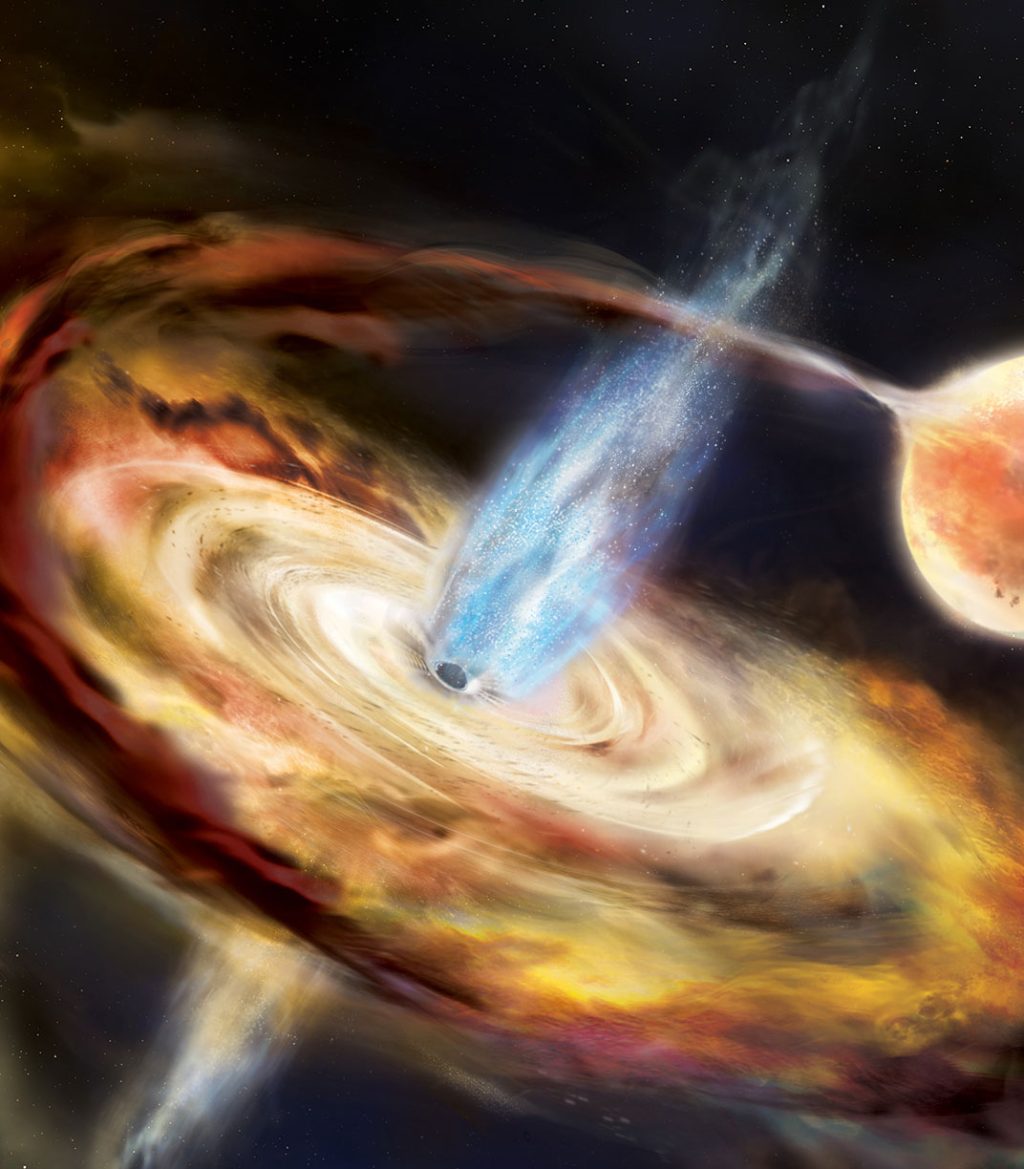In deze illustratie trekt een zwart gat materiaal van een nabije ster in een accretieschijf. Krediet: Aurore Simonnet en NASA’s Goddard Space Flight Center
De nieuwe bevindingen zullen wetenschappers helpen bij het volgen van een[{” attribute=””>black hole’s evolution as it feeds on stellar material.
Tens of millions of black holes are strewn across our Milky Way galaxy. These gravitational wells of spacetime are so enormously powerful that infalling matter, and even light, can never escape. Except on rare instances when they feed, black holes are inherently dark. As a black hole absorbs gas and dust from an orbiting star, it can emit stunning bursts of X-ray radiation that bounce and reverberate off the inspiraling gas, briefly illuminating a black hole’s extreme surroundings.
Now MIT astronomers are looking for flashes and echoes from nearby black hole X-ray binaries — systems with a star orbiting, and occasionally being eaten away by, a black hole. They are analyzing the echoes from such systems to reconstruct a black hole’s immediate, extreme vicinity.
In a study appearing published on May 2, 2022, in The Astrophysical Journal, the researchers report using a new automated search tool, which they’ve named the “Reverberation Machine,” to comb through satellite data for signs of black hole echoes. In their search, they have discovered eight new echoing black hole binaries in our galaxy. Previously, only two such systems in the Milky Way were known to emit X-ray echoes.
In comparing the echoes across systems, the team has pieced together a general picture of how a black hole evolves during an outburst. Across all systems, they observed that a black hole first undergoes a “hard” state, whipping up a corona of high-energy photons along with a jet of relativistic particles that is launched away at close to the speed of light. The researchers discovered that at a certain point, the black hole gives off one final, high-energy flash, before transitioning to a “soft,” low-energy state.
This final flash may be a sign that a black hole’s corona, the region of high-energy plasma just outside a black hole’s boundary, briefly expands, ejecting a final burst of high-energy particles before disappearing entirely. These findings could help to explain how larger, supermassive black holes at the center of a galaxy can eject particles across vastly cosmic scales to shape a galaxy’s formation.
“The role of black holes in galaxy evolution is an outstanding question in modern astrophysics,” says Erin Kara, assistant professor of physics at MIT. “Interestingly, these black hole binaries appear to be ‘mini’ supermassive black holes, and so by understanding the outbursts in these small, nearby systems, we can understand how similar outbursts in supermassive black holes affect the galaxies in which they reside.”
The study’s first author is MIT graduate student Jingyi Wang; other co-authors include Matteo Lucchini and Ron Remillard at MIT, along with collaborators from Caltech and other institutions.
X-ray delays
Kara and her colleagues are using X-ray echoes to map a black hole’s vicinity, much the way that bats use sound echoes to navigate their surroundings. When a bat emits a call, the sound can bounce off an obstacle and return to the bat as an echo. The time it takes for the echo to return is relative to the distance between the bat and the obstacle, giving the animal a mental map of its surroundings.
In a similar fashion, the MIT team is looking to map the immediate vicinity of a black hole using X-ray echoes. The echoes represent time delays between two types of X-ray light: light emitted directly from the corona, and light from the corona that bounces off the accretion disk of inspiraling gas and dust.
The time when a telescope receives light from the corona, compared to when it receives the X-ray echoes, gives an estimate of the distance between the corona and the accretion disk. Watching how these time delays change can reveal how a black hole’s corona and disk evolve as the black hole consumes stellar material.
Echo evolution
In their new study, the team developed a search algorithm to comb through data taken by NASA’s Neutron star Interior Composition Explorer, or NICER, a high-time-resolution X-ray telescope aboard the International Space Station. The algorithm picked out 26 black hole X-ray binary systems that were previously known to emit X-ray outbursts. Of these 26, the team found that 10 systems were close and bright enough that they could discern X-ray echoes amid the outbursts. Eight of the 10 were previously not known to emit echoes.
“We see new signatures of reverberation in eight sources,” Wang says. “The black holes range in mass from five to 15 times the mass of the sun, and they’re all in binary systems with normal, low-mass, sun-like stars.”
As a side project, Kara is working with MIT education and music scholars, Kyle Keane and Ian Condry, to convert the emission from a typical X-ray echo into audible sound waves. Take a listen to the sound of a black hole echo here:
Krediet: stem berekend door Kyle Keane en Erin Kara, MIT. Animatie berekend door Michal Dovciak, ASU CAS.
Vervolgens voerden de onderzoekers het algoritme uit op 10 binaire bestanden van zwarte gaten en verdeelden de gegevens in groepen met vergelijkbare “spectrale timingkenmerken”, dat wil zeggen vergelijkbare vertragingen tussen de hoogenergetische röntgenstralen en de opnieuw verwerkte echo. Dit hielp om de verandering in röntgenecho’s in elk stadium tijdens de uitbarsting van het zwarte gat snel te volgen.
Het team identificeerde een co-evolutie in alle systemen. In de initiële “vaste” toestand, waar een halo en een straal van hoogenergetische deeltjes de energie van het zwarte gat domineren, ontdekten ze korte en snelle tijdvertragingen, in de orde van milliseconden. Deze moeilijke toestand houdt enkele weken aan. Vervolgens vindt de overgang plaats in de loop van enkele dagen, terwijl de corona en jets vervagen, zachte toestand en lage-energetische röntgenstraling regelen vanaf de accretieschijf van het zwarte gat.
Tijdens deze moeilijk-naar-zachte overgangstoestand ontdekte het team dat de vertraging langer werd in alle 10 systemen, wat impliceert dat de afstand tussen de corona en de schijf ook toenam. Een verklaring is dat de corona zich kort naar buiten en naar boven zou kunnen uitstrekken, in een laatste energierijke uitbarsting voordat het zwarte gat het grootste deel van zijn stellaire maaltijd beëindigt en afkoelt.
“We beginnen net deze echo’s van licht te gebruiken om omgevingen dichter bij het zwarte gat te reconstrueren”, zegt Kara. “We hebben nu aangetoond dat deze echo’s algemeen worden waargenomen, en we zijn in staat om de verbindingen tussen de schijf, de straal en de corona van een zwart gat op een nieuwe manier te onderzoeken.”
Referentie: “The NICER “The Echo Machine”: A Systematic Study of Time Delays in Black Hole X-ray Binaries” door Jinji Wang, Irene Cara, Matteo Luccini, Adam Ingram, Michel van der Kles, Guglielmo Mastrorio, Javier A. Thomas Dowser, Riley Connors, Andrew C. Fabian, James F. Steiner, Ron A. Remillard, Edward M. Caquet, Phil Oatley en Diego Altamerano, 2 mei 2022, Astrofysisch tijdschrift.
DOI: 10.3847 / 1538-4357 / ac6262
Dit onderzoek werd gedeeltelijk ondersteund door NASA.

“Amateur-organisator. Wannabe-bierevangelist. Algemene webfan. Gecertificeerde internetninja. Fanatieke lezer.”










More Stories
Live updates van de lancering van Starlink Falcon 9 op KSC
Deeltjes bestaan volledig uit kracht
Zou buitenaards leven zich kunnen verbergen in de ringen van Saturnus of Jupiter?